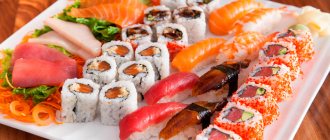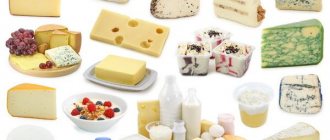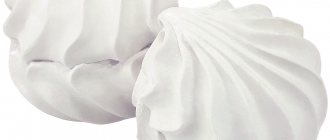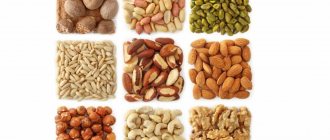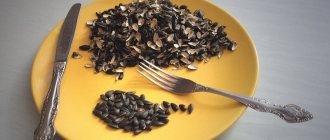Everyone probably has their own reasons to love Japanese cuisine. Exquisite chopsticks, unusual composition (nori, mamenori, tamago), novelty of recipes, natural ingredients - you can list their advantages for a long time. Sushi and rolls, traditional dishes of the Land of the Rising Sun, are especially loved all over the world. Healthy ingredients, beautiful design, wide range, affordable prices - how can you pass by a sushi bar or not place an order for home delivery?
However, anyone who is losing weight or trying to control their weight needs to know that the calorie content of rolls and sushi ranges from 50 to 330 kcal per 100 g of product, and one serving can weigh from 100 to 400 g. Therefore, there is a difference whether you take “ Boston" (100 kcal) or "Shanghai" (286 kcal). The first one will easily fit into your daily calorie intake, but for the sake of the second one you will have to give up a lot in your usual menu.
What are the advantages of Japanese cuisine
- The Japanese philosophy involves maximum trust in nature and immersion in it. Therefore, sushi is usually created based on natural products.
- A harmonious combination of ingredients is an important aspect of the exoticism and sophistication of a dish.
- Seasonings allow you to experience the unusual taste and enjoy the peculiarities of Japanese dishes.
- The original design attracts attention, Japanese food looks very aesthetically pleasing and arouses interest and a desire to try amazing dishes.
The energy value of sushi is so low that you can spend a fasting day on this dish.
PP sushi recipe
Another delicious and healthy recipe for sushi that you can safely eat even for dinner. For this recipe we will make a healthy paste with avocado, which will serve as an excellent filling for sushi.
So, to prepare a special paste you will need the following ingredients:
- avocado + 100 grams of low-fat cottage cheese + black pepper + salt + herbs.
Place all ingredients in a blender and beat until smooth. Now we won't need to use rice for our sushi.
Of the remaining ingredients we will need:
- nori leaves
- boiled shrimp
- cucumber.
Spread avocado paste onto a sheet of nori and place boiled shrimp and cucumber on top. Wrap it up and get a very healthy and tasty dish!
What products are Japanese dishes made from?
The main ingredient of rolls is rice. Properly prepared, it allows the body to quickly get enough. It contains carbohydrates and fiber - microelements vital for every person.
Fresh, smoked and salted fish, which is also one of the components of a complete Japanese dish, gives sushi a special taste. The freshness of the entire dish depends on the quality of the fish. Professional chefs - specialists in making sushi - know how to combine ingredients in such a way as to achieve the highest taste harmony. Rolls with salmon, tuna and eel are quite popular in Japanese restaurants; they are very nutritious, but low in calories.
Seafood, which is also indispensable during the cooking process, must be fresh and added to the rice in a certain quantity.
Vegetables, seaweed and seasonings play a special role in making sushi. Some of these ingredients add piquancy to the dish, while others are added to enhance or subdue the unusual flavor of the fish or seafood. The most popular vegetarian dish is rolls with avocado and cucumber.
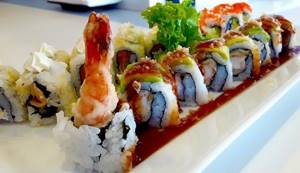
Diet Caesar roll
Do you like Caesar salad? Then you can prepare a Europeanized version of rolls. Since our dish will be dietary, we will use only healthy and correct ingredients.
- Nori sheet.
- Boiled rice. Ideally, it is better to use brown rice.
- Chicken fillet. Rinse, boil in salted water and cut into strips.
- Iceberg lettuce. Cut into strips.
- Tomato. Also cut into strips
- whole grain breads. We will use them for breading! You need to grind them in a blender so that it is convenient to roll the rolls in them.
For the special diet sauce you will need
- 7 tablespoons of natural yogurt + 1 teaspoon of mustard + 1 yolk + pepper + salt. Mix everything or beat in a blender. PP sauce is ready!
To prepare a Caesar roll, you need to use a special mat. Place a layer of rice on a sheet of nori. Now your task is to carefully turn the nori over so that the rice lies on the mat. Fill the outer part of the nori - first lay out a layer of sauce, then chicken, iceberg lettuce and tomato. Very carefully roll up the sheet of nori. Now you need to roll the roll in crushed whole grain bread!
What is the benefit
- First of all, it is worth noting that this is a low-calorie food, which may well serve as the basis for a diet.
- The calorie content of Japanese cuisine varies, however, it does not exceed the calorie content of flour products and desserts. That is why restaurants with a similar assortment are more often visited by lovers of healthy food than coffee shops and eateries that offer fast food.
- Rice, seafood and vegetables contain large amounts of microelements that the human body lacks. By eating freshly prepared sushi, you can compensate for the deficiency of fiber, carbohydrates, phosphorus, vitamins and other substances.
Rolls are great for split meals. The volume of one serving is quite small, but they are satisfying and allow you to quickly satisfy your hunger.

Low calorie rolls
If you want to make low-calorie rolls, the best way to do it is using rice paper! Then you will be spared the need to add rice to your dish and thereby significantly reduce its calorie content. 100 grams of rice paper contains about 300 calories, but don’t make hasty conclusions! 1 small leaf (16 cm) contains only 20 calories, a medium leaf (22 cm) contains 47 calories! If you want to use a large leaf, you will get 56 calories!
Before wrapping your favorite ingredients in rice paper, place it in boiled cold water for 1 or 2 minutes. It is important that the water covers the entire leaf. The filling should be placed in the middle of the paper and then carefully wrapped.
Here are the best low-calorie options for filling:
- lettuce+cucumber+zucchini
- lettuce+shrimp+cucumber
- red caviar+cucumber+greens+tomato
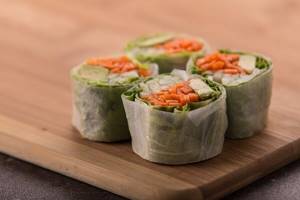
Sushi diet
Going on a diet and at the same time eating well without consuming extra calories is a great option. Since the roll is a very filling product, and the portions are small in volume, you can distribute meals throughout the day so that the body receives enough nutrition and at the same time consumes a minimum of calories. For example, Philadelphia allows you to get enough satiety with a low calorie content of the product. Vegetarian rolls with vegetables, seaweed and mushrooms are also perfect for your diet.
What is the sushi diet? First of all, this is fractional nutrition. Taking into account calories, you should create a menu for the day so that each meal includes sushi or rolls. In total, the entire daily diet should not exceed 1000 kilocalories.
Diet rolls at home
So, if you really want pp rolls on a diet, you can always prepare an exclusively dietary version. To do this you will need:
- 200 grams of cottage cheese. We will use this product instead of rice. This way you will immediately make pp rolls less calorie and also add protein to your diet.
- Natural yogurt. We will season the cottage cheese with it. A couple of tablespoons will be enough.
- 1 cucumber. You can use zucchini instead of cucumber. Wash and cut into strips.
- 100 grams of fish. If you use salted fish, it is better that it be lightly salted fish.
- Nori leaves. We will wrap the pp rolls in nori leaves. You will need 2 sheets. We cut each sheet into two parts, this will make it easier to wrap the pp rolls.
First, mix cottage cheese with yogurt. If desired, you can add any greens to the curd mixture.
Place the curd mixture on a sheet of nori and place fish and cucumber on top. Let's wrap it up.
Contraindications for use
- Don't get carried away with Japanese cuisine. It is quite unique, so one day a week is enough when you include one or two rolls in your diet, such as Philadelphia, California, Alaska or sushi, the basis of which is seaweed and vegetables, for example, a roll with cucumber.
- You should be very careful with raw fish. If you decide to prepare the dish yourself at home, make sure that all ingredients are fresh.
- Sushi has a very short shelf life, so when ordering it at a restaurant, check how long ago the dish was prepared. When making them at home, it is better not to put them in the refrigerator, but to eat them freshly prepared.
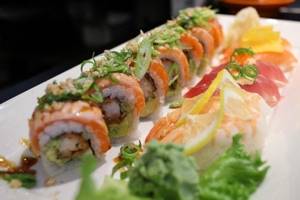
PP rolls with nori
This is an ideal option if you need to prepare a diet dish. You can wrap a huge number of ingredients in a sheet of nori, which form the basis of the menu. These pp rolls are very convenient to take with you and use as a snack or even a full lunch or dinner, depending on its filling. To prepare this dish you will need:
- chicken fillet. Boil the fillet in salted water and cut it into small pieces.
- quinoa. We use quinoa instead of rice in this recipe. These seeds contain more fiber and more nutrients.
- Spinach. Wash thoroughly and finely chop. You can leave large leaves if you prefer.
- Cucumber. Remove the skin and cut into small cubes.
- Tomato. Wash and cut.
- Carrot. You can grate it on a coarse grater.
Place the nori sheet on the table. The edges can be slightly moistened with water. In the middle we lay out the layers with the filling one by one and then tightly close the edges of the sheet, forming a round or oblong shape, as you like. You can put it in a plastic bag and put it in the refrigerator to seal the edges better.
Calorie table of the most popular rolls
| Name | Number of kcal. (in 100 g) |
| California | 176 |
| Philadelphia | 142 |
| Alaska | 90 |
| Unagi maki | 173 |
| Tempura | 165 |
| Kyoto | 155 |
| The Dragon | 189 |
| Philo | 90 |
| Tory Koonsay | 110 |
| Caesar | 113 |
| Vegetables | 70 |
Philadelphia and California rolls are the most popular in Japanese restaurant chains. Firstly, a set of 6-8 pieces is an excellent meal replacement. Secondly, these are the two most delicious and beloved types of sushi. Philadelphia contains rice, salmon, cucumber, avocado, Philadelphia cream cheese, and seaweed. The calorie content of such rolls is inferior to any spring roll or hamburger.
California roll is made from rice, tobiko flying fish roe, crab meat, seaweed and cream cheese. Cucumber and avocado are added. As you can see, these two options are similar in composition, but their taste is completely different.
The calorie content of Philadelphia and California rolls allows you to enjoy the taste of an exotic dish without gaining weight.
PP roll with red fish
What rolls are complete without red fish? Those who are on a diet should definitely include this product in their diet. Red fish contains a lot of useful substances, as well as omega 3.
For this recipe we will need the following ingredients:
- Brown rice. It should be cooked the same way as white rice. Wash thoroughly and fill with water (rice-water ratio 1:2). When the rice is cooked, leave it covered for about 20 minutes. Then season it with rice vinegar, which must first be mixed with sugar and salt.
- red fish. We cut it into strips.
- cucumber. Wash, cut off the skin and cut into slices.
- low-fat cottage cheese. You can add any herbs and spices to it.
Place a layer of rice on a sheet of nori, then curd cheese, fish and cucumber on top. Wrap it up and enjoy.
You can also try other variations for these rolls:
- lightly salted salmon + light Philadelphia cheese + cucumber
- boiled brown rice+avocado+tomato+red fish+greens
- red fish+hummus+cucumber+avocado
- low-fat cottage cheese + lettuce + shrimp + avocado
- lightly salted salmon+tofu+cucumber+lettuce
Sashimi. Did you know that “sashimi” is not sushi at all...
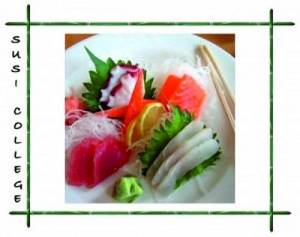
Today we would like to present to your attention one of the most popular delicacies in Japan - sashimi! We recently looked at nigiri, and in this article you will get acquainted with the history of the origin of sashimi, their features and other interesting facts, and also look at sashimi photos. We wish you pleasant reading.
For the Japanese, their food is very important. They care not only about her taste, but also about her appearance. A Japanese proverb says:
While it is fresh, natural and beautiful - let it seem larger than necessary!
And so, let's sort out the sashimi!!!
The deep roots of the word “sashimi” go back to the times of the samurai. The samurai used the word “kiru” instead of the word “sashimi”, which meant “to cut”, “to cut” (you can guess who and how...). Cooks considered the word "ki iru" unfavorable and replaced it with "sashimi", which means "sharp knife". This meaning has survived to this day. Everything is clear here, let's move on.
Sashimi is a dish consisting of slices of fillets of various fish cut in a special way (using a special knife, such a knife is called a sashimi knife), which is served with vegetables and traditionally: with soy sauce, wasabi and ginger. You can read more about how to cut fish here
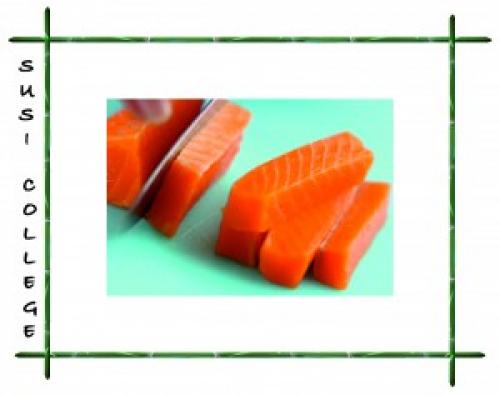
So is sashimi sushi or not?!?
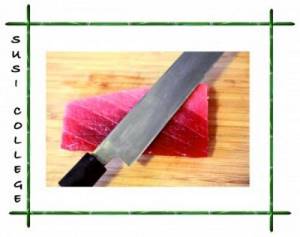
Many people, like us before, have mistaken sashimi for sushi. As we wrote earlier in the article, sashimi differs from sushi in that it is eaten completely without rice. And therefore, the main rule is the freshness of the fish, because the subtle tastes of seafood will not mix with the taste of sushi - rice. The Japanese say that fresh fish is the key to delicious sashimimas. In modern European sushi bars, sashimi can be found from any fish, although in Japan they use exclusively sea fish, since they consider freshwater fish unsuitable for sashimi because of its bonyness and the smell of mud. Therefore, we do not recommend making sashimi from pike or crucian carp!

Of all the fish dishes, the Japanese themselves consider sashimi their favorite dish and always eat it first - before sushi. As we know, the Japanese are great connoisseurs of subtle tastes. This is probably why they eat sashimi first, to appreciate the taste of each piece of fish.
In Japan, sashimi is served with alcoholic drinks such as sake, Japanese liqueurs and dry white wine, as well as Japanese teas.
In the article about nigiri, you learned that nigiri is served in pairs. But unlike nigiri, sashimi is placed on a plate with an odd number of fish slices, giving the sashimi a different design.
Calorie content of sauces and ginger
Additionally, you should pay attention to hidden calories. For example, when preparing a dish, a rich sauce or mayonnaise may be used. Yes, even the most ordinary soy sauce can contain extra calories. Read its composition - it should not contain wheat. Also give preference to naturally fermented sauces. Don't forget the ginger. If it was marinated in sugar, then this will also have a bad effect on your figure.
Speaking of vegetable rolls. Although they are quite dietary in themselves, you should not overeat them. Since they contain vegetables and rice, this makes them mainly carbohydrates, and, therefore, you may feel hungry earlier.
As you can see, everyone can choose low-calorie and light rolls to their liking. Among all the variety you can find both completely dietary and more nutritious rolls. In our restaurant you can order low-calorie and light rolls from a large assortment.
As a result, although some rolls can be called a low-calorie dish, debate about their benefits for the human body still continues. However, there is a list of completely dietary and light rolls that definitely won’t bring you extra pounds. You can always order low-calorie rolls in our restaurant.
